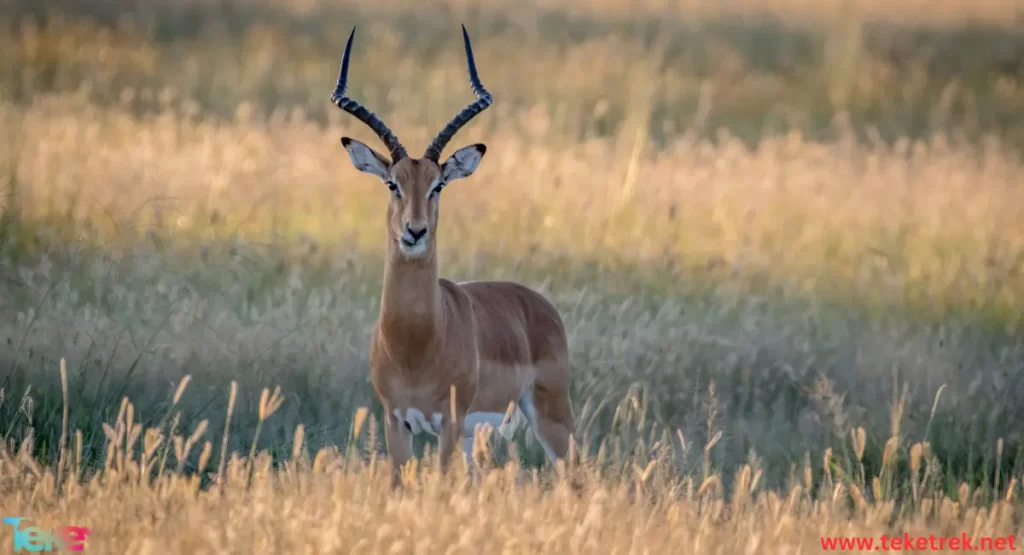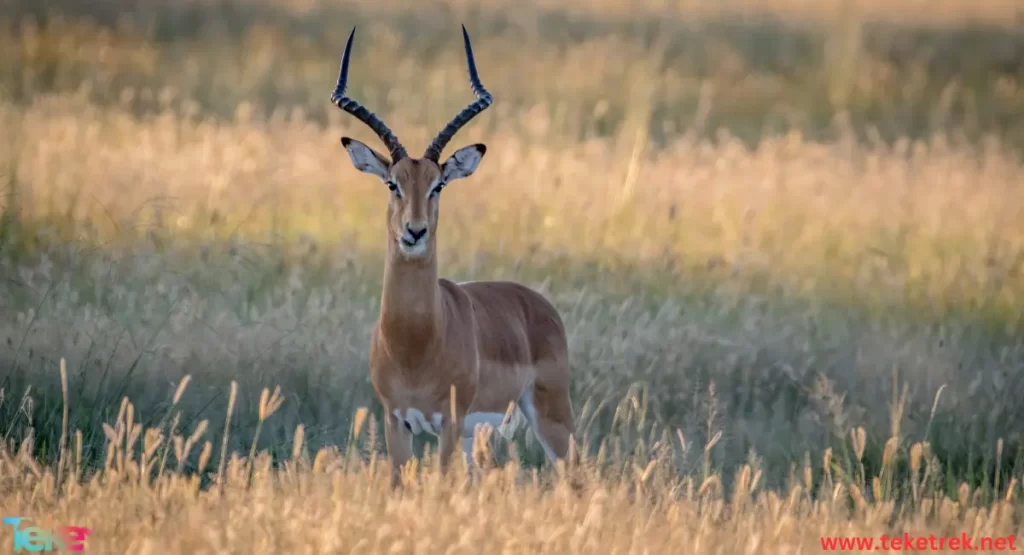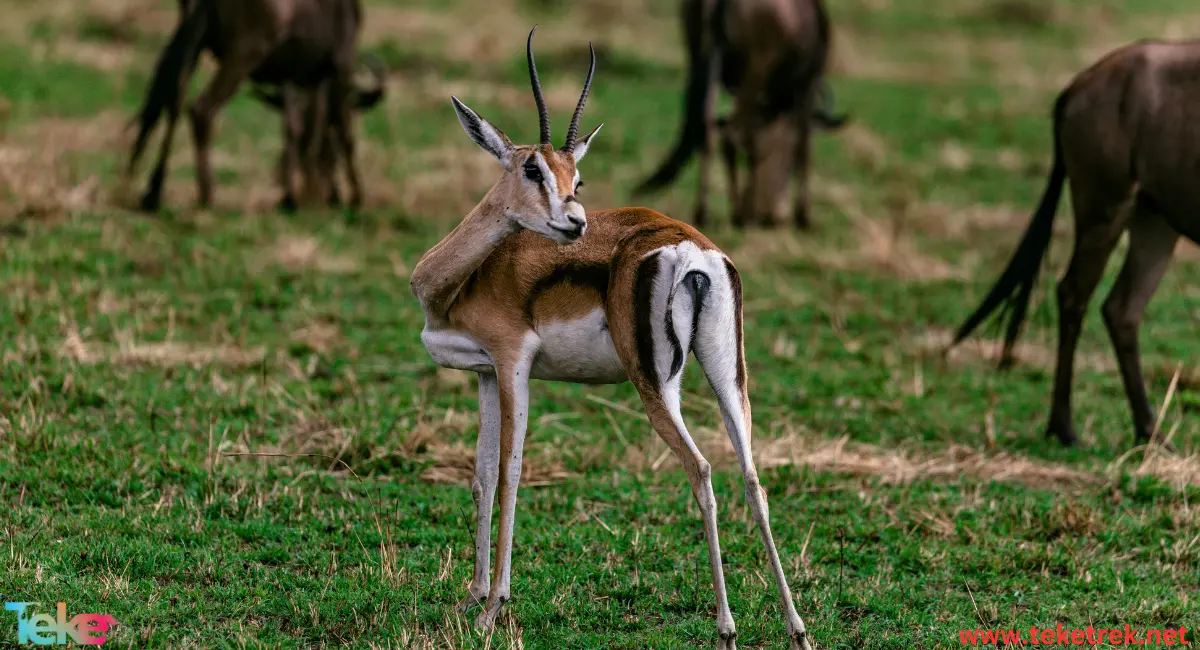The gazelle is considered to be a graceful and beautiful animal that is always prey to predators. It is one of the known types of antelopes, renowned for its great speed and ability to run at speeds reaching 100 kilometers per hour or maintaining a steady speed of 50 kilometers per hour.
In this article from Teketrek we will talk more about it.
The appearance of the gazelle
- The scientific name for the gazelle is “Cervidae,” derived from the Latin word “Cervus,” which means “deer.
- Some gazelles have a distinctive tuft of black hair on their foreheads and small male horns protruding from their heads.
- Their coloration is characterized by intermingling shades of brown and white, with coarse hair on the back.
- The gazelle is classified as a cloven-hoofed mammal belonging to the Bovidae family. It typically weighs between 18 to 25 kilograms, which makes its body well-suited for rapid running. Additionally, it is relatively small in size, with a height ranging between 60 to 110 centimeters.
- It has large, dark eyes, slender ears, and a short tail.
- The lifespan of a gazelle ranges between 10 and 25 years, although reaching the age of 25 is challenging due to the risk of predation.
- Large eagles or wolves prey on this animal, but it can protect itself by creating a defensive aura.
The habitats and locations where gazelles reside
- Gazelles rely on selecting suitable habitats for living based on the types of buds and grasses available. They are commonly found in tropical forests, savannas, and vast wild grasslands. However, there are two regions where gazelles cannot live due to extreme cold: the southern continent and the continent of Australia.
- In Central and South America, there are species of small gazelles.
- Some species of gazelles live in mountains, sandy areas, and near tall grasses.
Species of gazelles
- There is a wide range of gazelle species, each of which lives in the area that suits it best, with preferred food and an environment where it can survive as much as possible
Let’s mention the most important species of gazelles:
- Waterbuck Gazelle:
This type of gazelle lacks horns but has prominent canines that it displays to intimidate predators.
- Boody Gazelle:
It is the smallest species of gazelle, with a length of about 12 to 17 inches.
- Indian Muntjac Gazelle:
This species is often concealed in dense forests and can emit a loud alarm call.
- Dwarf Brocket Gazelle:
This gazelle resembles the Indian Muntjac species and is found in the Yucatan Peninsula.
- Red Deer:
The red deer is one of the largest wild mammals in Britain, and there are numerous laws aimed at protecting this species.
- The Gerenuk Gazelle:
It lives in Africa and is known for its long, branched horns used in male battles to win females. It is characterized by its ability to jump skillfully and swiftly to escape predators, and it lives in grassy areas and mountainous terrain.
Reproduction in Gazelles
- Gazelles live in herds consisting of males, females, and juveniles. During the mating season, males engage in sparring, butting heads, and pushing each other with their horns. The victorious gazelle mates with the females. The mating season typically begins in the fall, and pregnancy lasts for approximately six months.
- Most species of gazelles follow a mating strategy known as polygyny, where a dominant male has multiple female partners. Only a few species prefer monogamous mating.


Gazelle food
- The primary food of gazelles consists of green grasses, short plants, fruits from some trees, and crops such as corn and cotton, so that it herbivorous.
- The diet of gazelles varies depending on the species. For example, the white-tailed deer primarily consumes grass but prefers clover plants.
- Gazelles, like cattle and sheep, practice rumination, which means they swallow food as much as possible, then regurgitate it back into their mouths to chew it slowly.
Protecting gazelles from extinction
There are many international efforts aimed at conserving these animals from extinction, such as protecting their habitats, reducing pollution, and conducting awareness sessions to save the animals.
Some fascinating facts about gazelles
- When gazelles feel stressed, they emit specific sounds such as snorts, grunts, or hisses.
- Gazelles can leap into the air on their hind legs, displaying tricks to impress their predators. For instance, when fleeing, they perform a distinctive vertical leap with their sturdy legs. Gazelles are among the fastest wild animals in terms of leaping, capable of jumping up to 3 meters high and reaching speeds of up to 80 kilometers per hour.
- Gazelles can leap into the air on their hind legs, displaying tricks to impress their predators. For instance, when fleeing, they perform a distinctive vertical leap with their sturdy legs. Gazelles are among the fastest wild animals in terms of leaping, capable of jumping up to 3 meters high and reaching speeds of up to 80 kilometers per hour.
- Gazelles can reduce the size of their heart and liver, adapting to life in dry environments. By reducing their liver and heart size, they can breathe less and consume less oxygen, reducing the amount of water lost due to respiratory evaporation.
- Gazelle horns are distinctive for their lack of a keratin layer, unlike horns of other animals.
- Gazelles typically emerge to forage shortly after dawn and again after dusk.
- Gazelles possess a strong sense of hearing, with numerous muscles in their ears allowing them to move in any direction without moving their heads.
- Gazelles have good night vision, which is useful for them when venturing out in the early morning and near dawn.
- Gazelle horns shed and regrow every year after the mating season ends, taking several months to reach full maturity. The primary purpose of gazelle horns is to assist in fighting and mating.
- Gazelles produce distinctive scents from glands located on their heads and legs, providing information about the gazelle’s gender, social status, and physical condition.
- Female gazelles protect their young by hiding them in tall grass to shield them from predators.


FAQ
- Why is the gazelle a symbol of beauty?
Because he is graceful and smooth in his movements, with wide, bright eyes.
- Is the gazelle a pet or a wild animal?
Gazelle are a domestic animal, but that is not absolute, as wild species have been found in America.
- What are the characteristics of a gazelle?
The gazelle is a small animal whose height ranges from 60 to 110 cm. It is fast moving, running at a speed of 100 km/h. It lives in herds and eats grasses.
Finally, we can say that the gazelle is a graceful, beautiful, and highly intelligent animal capable of easily adapting to its environment. It plays a vital role in ecosystem regulation. However, it’s important to note that gazelles have an instinct to flee from potential threats, so direct contact with humans is uncommon. Nevertheless, due to their size and horns, caution should be exercised when interacting with them.






